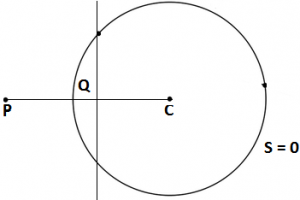Circles – Inverse Points
Let S = 0 be a circle with center C and radius r. two points P, Q are said to be inverse points with respect to S = 0 if.
1. C, P, Q are collinear
2. P, Q lies on the same said of C
3. CQ = r²

Note:
1. Let P, Q be a pair of inverse points with respect to the circle S = 0, if P lies insides the circle S = 0 then Q lies outside the circle S = 0. If P lies on the circle S = 0 then Q = P
2. If P, Q are a pair of inverse points with respect to a circle S = 0 then Q is called inverse point of P.
3. The inverse point of a point P with respect to a circle S = 0 is unique.
Theorem: Let S = 0 be a circle with center C and radius r. the polar of a point P with respect to the circle S = 0 meets CP in Q if P, Q are inverse points with respect to S = 0
Proof: Suppose the polar of P with respect to S = 0 meets CP in Q. Let S = x² + y² + 2gx + 2fy + c = 0 be the given circle.
Center C = (-g, -f)
Radius \(r=\sqrt{{{g}^{2}}+{{f}^{2}}-c}\)
Let P (x₁, y₁)
The polar of P with respect to S = 0 is S₁ = 0
xx₁ + yy₁ + g (x + x₁) + f (y + y₁) + c = 0
(x₁ + g) x + (y₁ + f) y + (g x₁ + f y₁ + c) = 0 ….(1)
Slope of (1) is
m₁ = – (x₁ + f) / (y₁ + f)
Slope of CP is
m₂ = (y₁ + f) / (x₁ + g)
Product of the above slopes = -1
CP is perpendicular to the polar of P
CQ = the perpendicular distance from C to 1
= \(\frac{\left| ({{x}_{1}}+f)(-g)+({{y}_{1}}+f)(-f)+g{{x}_{1}}+f{{y}_{1}}+c \right|}{\sqrt{{{({{x}_{1}}+g)}^{2}}+{{({{y}_{1}}+f)}^{2}}}}\)
= \(\frac{\left| {{g}^{2}}+{{f}^{2}}-c \right|}{CP}\) \(\frac{\left| {{g}^{2}}+{{f}^{2}}-c \right|}{CP}\)
\(=\frac{{{r}^{2}}}{CP}\)
1. CQ = r²
Q is the inverse point of P with respect to S = 0
Let the polar of P respect to S = 0 meets CP in R
Then P, R are inverse point with respect S = 0
R is the inverse of P with respect to S = 0
Since the inverse point of P with respect to S = 0 is unique, R = Q
The polar of P with respect to S = 0 meets CP in Q.
